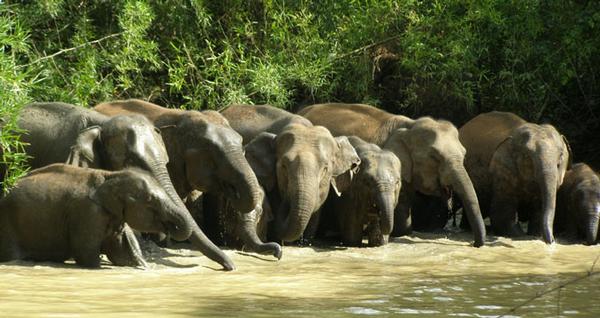I have to admit it. I have been on an elephant ride in Thailand a few years ago. And it was one of those where you sit in a seat on the elephants’ back. I have learnt during the years that there are many reasons not to go on those elephant rides. One of the reasons is that elephants have weak backs and when riding an elephant you should sit on their neck. When I visited Pai, north west of Chiang Mai in northern Thailand I become good friends with Kate, a young English woman. She was about to go volunteering for the Elephant Nature Park in Mae Taeng Valley, about 60 kilometres north of Chiang Mai. She told me many interesting things about saving the Thai Elephants. That is why I am writing this blog. To tell you guys how elephants are treated in Thailand, that they are endangered and in what beautiful way they work with the elephants in this specific park.
The Elephant Nature Park is part of the Elephant Nature Foundation which is a non profit foundantion. Their park differs from most other Elephant Parks in Thailand as they encourage the elephants to live as natural lives as possible. That means, for example, that they don’t have elephant rides for tourists and they let the elephants just sleep, eat and play.
In Thailand, the number of wild elephants has decreased a lot due to loss of forest the last century and are still suffering from poaching, live capture and by conflict with humans living on the edge of protected areas. Today there is no systematic monitoring systems in place throughout Thailand so the number of wild elephants are only estimated, making it difficult to assess whether Thailand’s elephants have continued to decline after better protection has been put in action.
The elephants in the Nature Elephant Park are rescued from different places. They might have had a bad life either from logging, trekking or street begging. Many of them will never be able to live as wild elephants as they have very traumatic pasts and have to have their own so called mahout who follows the elephant everyday. This is to protect the elephants as their living area is limited and as they are surrounded by a lot of people. All though they are not being controlled with a hook, only by orders.
Most tourists who go to Thailand want to go on an elephant trek. What most people don’t know is that most elephants in captivity have to go through a ceremony called the Phajaan. The elephants are between the age of three and six and are being forced into a cage to small for their bodies to fit. In the cages they are chained in place. The idea is to break the spirit of the elephant and the methods used are leaving them without, food, water and sleep and they are being poked with bamboo sticks with nails embedded in the ends and knives. They are also being thrown at with stones and other projectiles. The elephants go through this torture for about a week, but it can last longer. The length is controlled by the shaman, who has to sense that the elephant’s spirit has been changed. After this long and cruel torture they will many times continue to be tortured while being trained for shows and trekking.
One of the goals at the Nature Elephant Park is to train the elephants and their babies by positive reinforcement and teach the elephants the same command they are being taught in other places. The aim is to show people working with elephants that it is possible to train an elephant without torture.


Thank you for giving me a better insight as to how elephants in Thailand are treated. It was sad to read how the elephant’s spirit is broken…..so very cruel. This is something that probably happens around the world wherever there are elephants. Sad,
I’m glad you wrote this blog. It’s true that most people don’t know what can they really do to help the elephants and keep supporting it the wrong way.
Hope this message get to more people.
Thank you for writing your blogs. Your blog is very beautiful. There are all very interesting and helpful. Keep up the good work!
Thanks Ming for your comments. I really hope my blog will reach as many people as possible. 🙂 I am very happy and also very proud to join you guys at Isara in February. It is going to be great.
Thank you for writing this. When tourists indulge in their activities, they often close their eyes to the “behind the scenes” activities. I wish Thailand had a way to learn if the elephant population is stabilizing or not. 😦
Hi Ginafish 🙂 Thanks for commenting. Yes I wish so too. What I have heard they only estimate now as they stopped monitoring the elephant population in the late 90s. Thanks for reading my blog.
Found your posting looking for a good pic to make into a new banner since I am going to the Elephant park in Jan to volunteer. Great post. Would it be ok to use your pic?